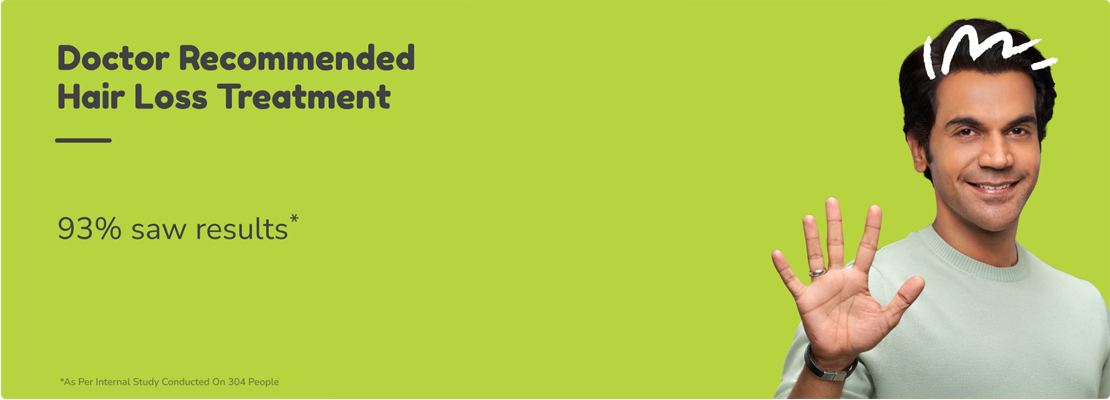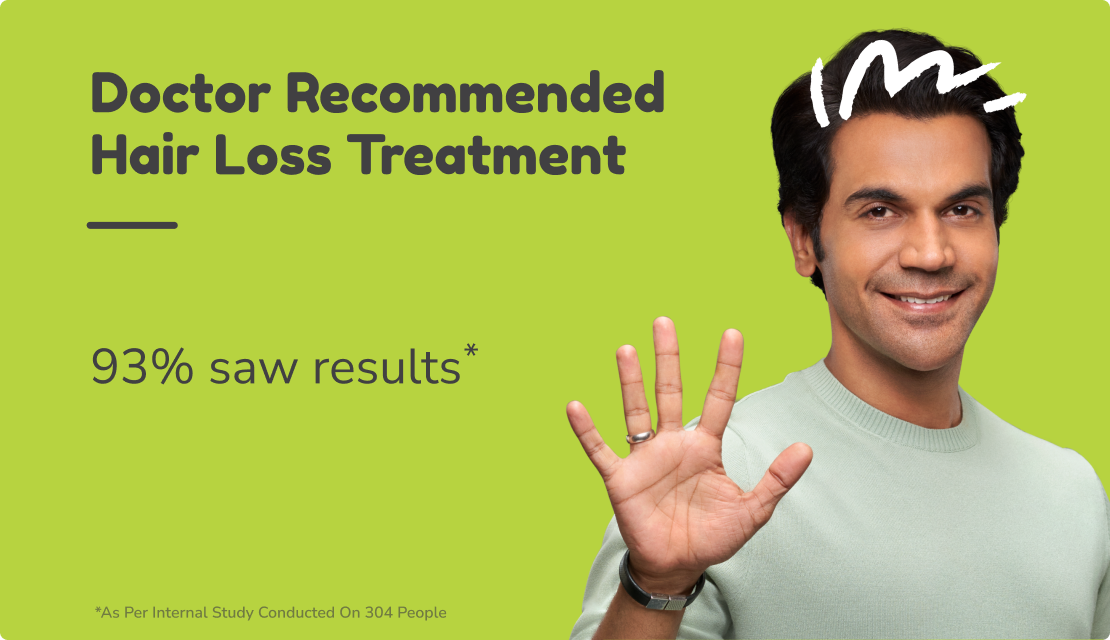Do these terms baffle you? Don’t worry we’ll quickly explain to you everything about androgenic alopecia.
Hair fall is a very common delinquent which can be seen in numerous people. But male pattern baldness is one major cause of hair fall in men. Baldness in men generally occurs in adult males who are more than 50 years of age. A study also states that male pattern baldness is a very common hair loss type in men and more than 60% of the males can get affected by men's hair balding.
What is Androgenic Alopecia?
Male Pattern Baldness or Androgenic Alopecia is a genetic hair loss condition that is triggered by excess levels of dihydrotestosterone (DHT). It is commonly known as male pattern baldness or female pattern hair loss. Although the main cause of this condition is DHT, other internal health issues like diet, stress, sleep, and lifestyle factors also have an effect on it. This Male pattern baldness has 7 stages which are determined by something known as the Norwood Scale (for men) or Sinclair Scale (for women) of androgenic alopecia.
In men, this hair fall starts as a receding hairline or thinning around the scalp vertex. And eventually leads to increased scalp visibility and partial baldness on the front and top portion of the scalp. Whereas, in women, it presents as thinning around the hair partition. Causing the partition to widen. In some cases where female pattern hair loss is a result of traction alopecia, it can also cause a receding hairline. While there is no complete balding in women, partial balding that results in increased scalp visibility is possible.
Like all hereditary conditions, androgenic alopecia also has an onset period. Early-onset, wherein one experiences hair loss in their 20s and 30s. And late-onset wherein one experiences hair loss in their 40s, 50s or 60s. Studies have shown that in the last ten years, younger generations (the 20s and 30s) are experiencing hair loss due to high stress, poor lifestyle and nutrition habits, and exposure to internal and external pollution.
Also Read: Male Pattern Baldness
What Causes Androgenic Alopecia?
Androgenic alopecia occurs due to a combination of genetic factors along with internal health issues, diet, lifestyle and environmental factors. Research has established that this type of hair loss is caused by an androgen hormone known as dihydrotestosterone (DHT). Androgens are also very crucial for the development of male and female sex organs at birth and on the onset of puberty. However, excess levels of DHT combined with genetic susceptibility and other triggers can result in pattern hair loss. It is important to understand that DHT or testosterone doesn't cause hair loss directly.
Let’s first understand the hair growth cycle in short.
Your hair has a lifecycle. After growing for a period of about 2 to 6 years, which varies from person to person. It goes into a resting phase only to eventually fall out. The follicle then begins to grow new hair and the cycle begins all over again. The hair in the resting phase is what results in normal hair shedding that you see day-to-day.
In those who are susceptible to androgenic alopecia, the androgens (DHT) bind with hair follicles and start shrinking them. This results in the shortening of the growth phase and also increases the period of time it takes for your hair follicles to grow new hair. This will lead to shorter and thinner quality of hair which will eventually lead to balding if untreated. Certain health conditions such as thyroid or polycystic ovary syndrome (PCOS) can also aggravate pattern hair loss.

According to Ayurveda, hair loss is a result of poor internal health and therefore linked to your digestion, metabolism, absorption, sleep quality, stress, diet and hormonal balance. And therefore, Ayurvedic treatment for androgenic alopecia starts with fixing your internal health.
What are the Symptoms for Androgenic Alopecia?
On average, a person sheds approximately 80-100 strands every day which is considered normal shedding. However, if you are noticing that your hairline is receding, meaning your forehead is larger than before. Or notice hair thinning which is making your scalp more visible; it means you are experiencing pattern hair loss.
- Symptoms In Men
Men can refer to the Norwood scale (above) to understand what their hair fall stage is. Because treatment and recovery of androgenic alopecia depend upon the stage and your age. Therefore, at Traya we guarantee results only for those between the stage of 1-4.

Symptoms depending on the stage of hair loss:
Stage 1: Uneven hairline and slightly larger forehead than before.
Stage 2: Hair starts to recede near the temples and mild hair thinning which is visible only when hair is wet or oiled.
Stage 3: Here’s where the symptoms of clinical balding appear. The hairline faces recession at both temples and the hairline appear as a characteristic M, U, or V shape.
Stage 4: There is evident thinning of hair on the crown area.
Stage 5: There is a small patch that has hair on the receded hairline and very thin hair in the crown area.
Stage 6 & 7: the crown area where you have bald patches that have dead follicles which can no longer be revived with simulators such as minoxidil.
- Symptoms In Women
Similar signs of hair loss in women are seen. A slow but sure thinning of the hair on the top of the scalp is the most common phenomenon for women suffering from androgenic alopecia. Women generally see their hair partitions widen. This partition starts getting wider with each advancing stage and the scalp also starts getting more visible. Women may also experience that their ponytail becomes thinner and hair growth gets stunted. So you may feel your hair is not growing beyond a certain length. In some women, androgenic alopecia can present as a receding hairline as a result of something known as traction alopecia. This happens when you wear your hair too tight in a ponytail or a bun.
Can Androgenic Alopecia be Cured?
It is important to note that Androgenic alopecia cannot be cured but with preventive treatment and early intervention between stages 1-4, it can be successfully managed. This means your hair fall and hair thinning will stop and you will be able to recover some portion of the volume and density that you have lost.
The recovery percentage, however, depends on your age and the stage at which you are. Also, as discussed earlier it is important to understand that because androgenic alopecia is a complex hair loss condition that is not affected by a single factor but has multiple triggers. It is important to choose a holistic treatment that fixes the different root causes and symptoms simultaneously. This condition is managed by modern medicine and the two commonly prescribed FDA approved treatments used are topical minoxidil, topical or oral Finasteride. Redensyl, Procapil and Capixyl are novel inventions that have also proved their clinical efficacy.

What is Traya’s Treatment Plan for Androgenic Alopecia
Androgenic Alopecia is a hair loss condition and therefore requires proper diagnosis and a doctor-prescribed treatment. You should therefore not rely on hair care products such as shampoos, oil, serums, or home remedies to treat it. Not only will this not give you any results but also you may end up missing out on improving your internal health which is affecting your hair health.
Traya offers a holistic treatment for hair loss conditions. It has a unique approach that comes from combining Ayurveda, dermatology, and nutrition. To ensure consistency, Traya has created an army of hair coaches. These doctor-trained individuals act as personal trainers who make sure that you stay on track and adhere to the treatment diligently. Traya treatment is prescribed by doctors. There is a team of doctors on the backend that analyzes every case and prescribes dosage accordingly.
It is important to remember that the treatment should be used for a minimum of 5 months to see results. However, treatment durations vary between 5 months to 1 year to see results depending on your stage of androgenic alopecia and age.
FAQs
- Can androgenetic alopecia be prevented?
Yes, with early intervention between the stages of 1-4 it can be managed. And baldness can be prevented. In fact, starting in the first stage can prevent one from progressing any further in terms of hairline and crown area density. But there is nothing one can do to prevent androgenic alopecia from happening altogether.
- Does androgenetic alopecia lead to baldness in women?
Androgenetic alopecia can affect both men and women. It can cause hair thinning, increase hair loss and increase scalp visibility in both. However, men can go partially or completely bald. Women only experience partial baldness. Unless they are suffering from alopecia totalis.
- What is the best treatment for androgenetic alopecia?
Holistic treatment is the best treatment for androgenic alopecia because it is a complex hair loss condition affected by multiple factors. In the early stages, it can be treated with FDA approved regrowth solutions and ayurvedic medicines. However, from stage 5 onwards the best treatment is a transplant.
- What is the cause of androgenetic alopecia?
Androgenic alopecia is a genetic condition and is triggered by excess levels of dihydrotestosterone (DHT) converting into the enzyme alpha-reductase. However, it is affected by other internal health factors, diet, lifestyle and exposure to environmental factors and pollution.




